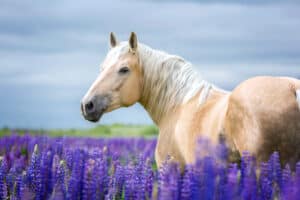Horse mating and equine reproduction is a remarkable process lasting approximately an entire year. Each stage plays a vital role, from ovulation and fertilization to embryonic development and gestation. Whether natural or through intentional breeding efforts, veterinarians utilize advanced techniques to ensure the well-being of the mare (female horse) and the developing foal (newborn horse). Let’s explore equine reproduction and the modern intricacies that accompany the process.
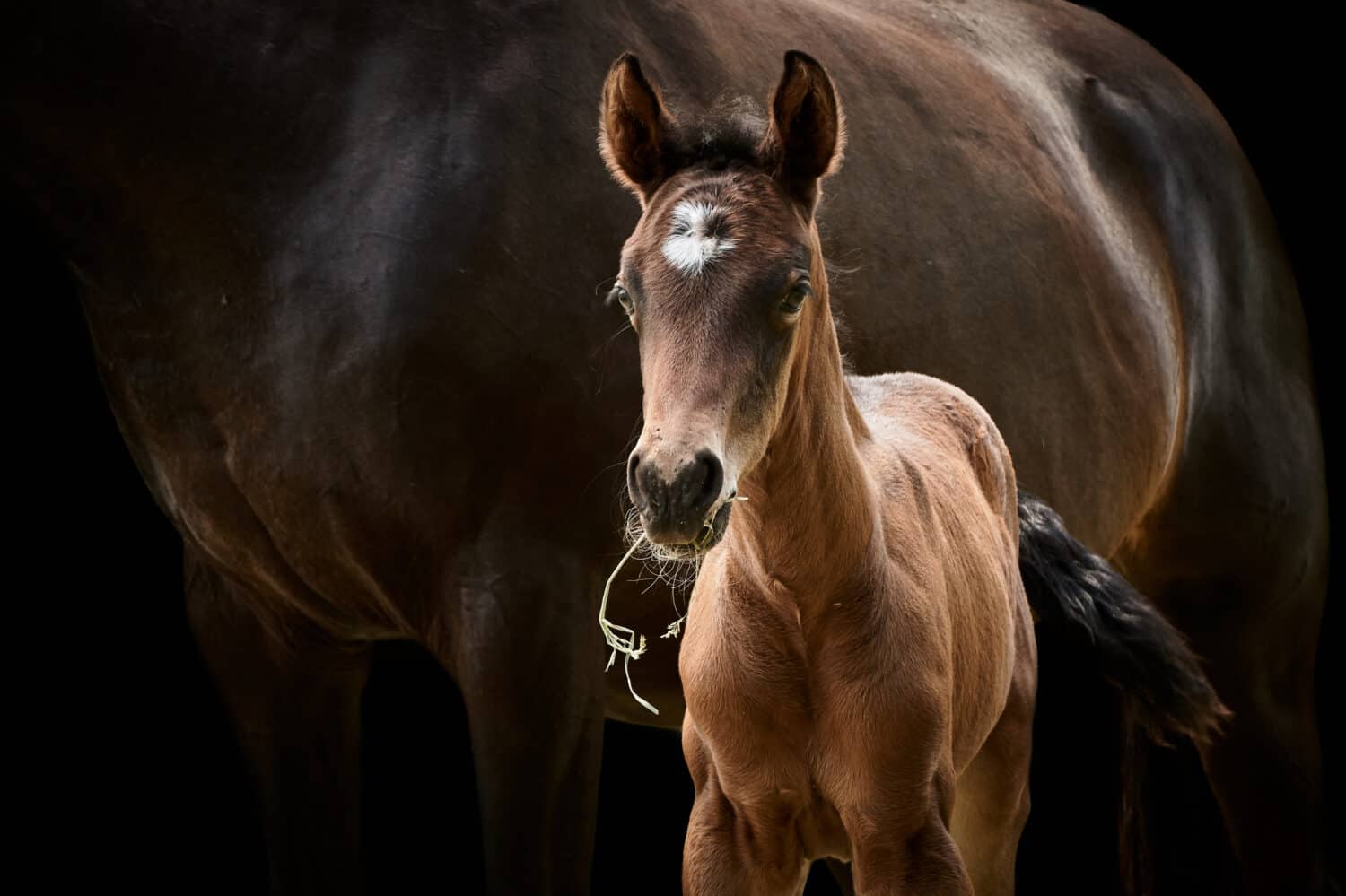
Equine reproduction, from ovulation to birth of the foal, lasts in duration for approximately one year.
©Thomas Marx/Shutterstock.com
The Equine Estrous Cycle
The estrous cycle, a crucial phase in a mare’s reproductive journey, plays a vital role in the successful conception of horses. It is comparable to the menstrual cycle of humans. Owners, breeders, reproductive specialists, and veterinarians are deeply invested in understanding and monitoring this stage to optimize breeding and ensure the health and well-being of their mares.
The estrous cycle in horses typically lasts around 21 days and comprises four distinct stages: proestrus, estrus, metestrus, and diestrus. Each stage is marked by specific behavioral and physiological changes in the mare, providing valuable indications to veterinarians.
The First Stage
The first stage, proestrus, is characterized by a gradual increase in estrogen levels. During this time, mares may exhibit signs of restlessness and frequent urination. The cervix also starts to relax, allowing the uterus to prepare for potential fertilization.
The Second Stage
Estrus, the second stage, is the most crucial phase for breeding. It is often referred to as the “heat” phase, as mares become receptive to the advances of stallions (intact male horses). When the estrogen level peaks, it causes behavioral changes such as tail-raising, “winking” of the vulva, and increased vocalization. Monitoring the mare’s behavior during estrus is crucial for determining the optimal time for breeding.
The Third and Fourth Stages
Metestrus and diestrus are the final stages of the estrous cycle, during which hormonal changes signal the body to prepare for potential pregnancy or return to a non-fertile state. If the mare is not bred during estrus, she will go through diestrus, and the cycle will repeat.
During this aspect of equine reproduction, veterinarians use various methods to accurately monitor the mare’s estrous cycle. Observing the mare’s behavior and physical signs is essential for determining the onset of estrus and the best time for breeding. Additionally, veterinarians can employ hormonal assays to measure hormone levels in the mare’s blood or urine, providing objective data to confirm the different stages of the estrous cycle.
Ultrasound technology is another invaluable tool for monitoring the reproductive cycle. By conducting regular transrectal ultrasounds, veterinarians can visualize changes in the mare’s ovaries and track the development of follicles and the presence of a mature ovum before ovulation occurs.
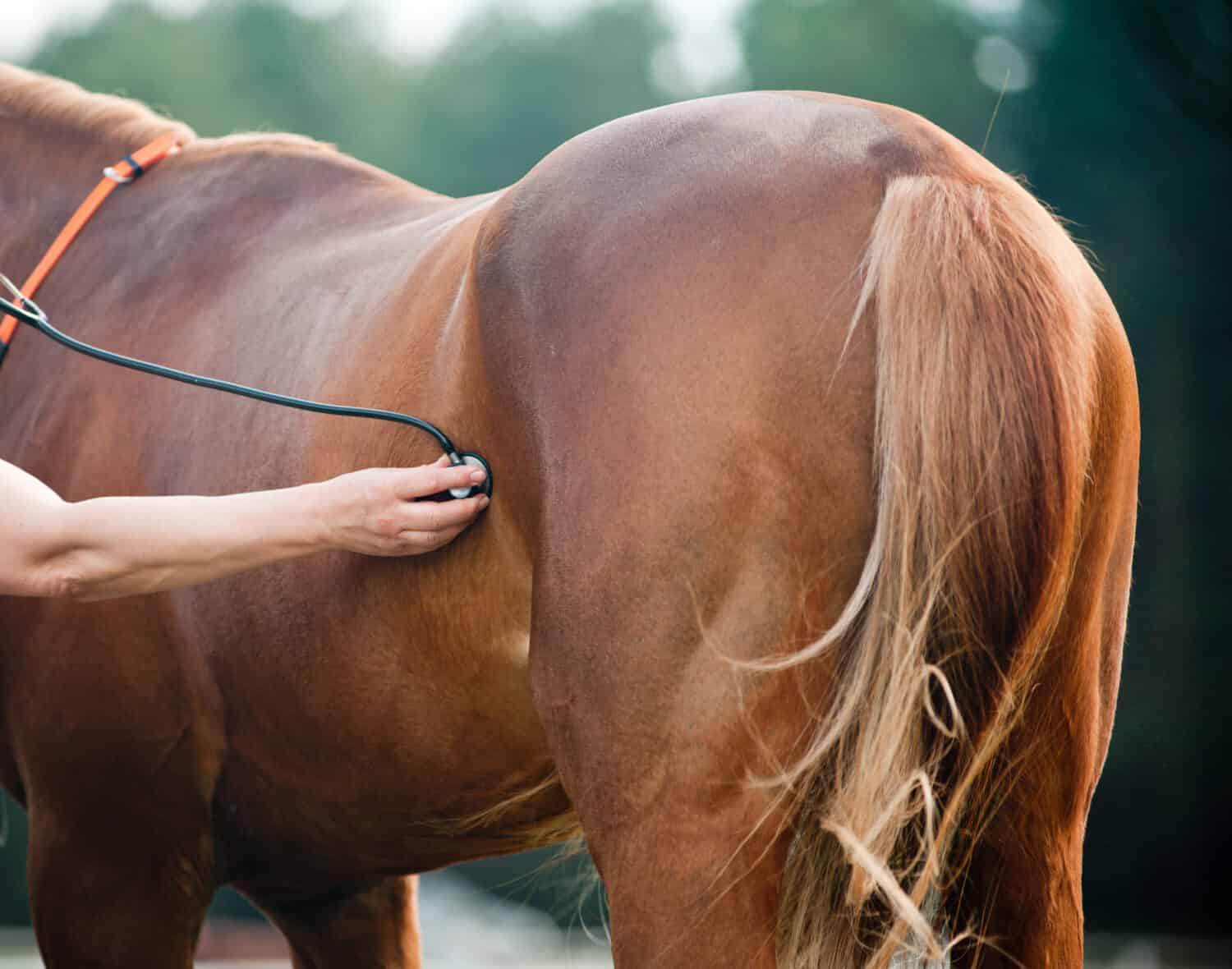
Veterinarians are an integral part of horse breeding and monitoring pregnant mares.
©mariait/Shutterstock.com
Monitoring Equine Ovulation
Ovulation is a pivotal stage in the equine reproduction process, representing the release of a mature egg from the mare’s ovaries, paving the way for potential fertilization. Closely monitoring ovulation is crucial to ensure optimal timing for successful mating and conception.
Ovulation in horses is triggered by the surge of luteinizing hormone (LH) in the bloodstream, which induces the release of a mature oocyte from the follicle on the ovary. This process typically occurs around 24 to 48 hours before the mare’s estrous cycle ends, during the estrus phase, when she is receptive to breeding.
Veterinarians employ several methods to monitor ovulation in mares accurately. One commonly used technique is transrectal ultrasound, which allows veterinarians to visualize the ovaries and track the development of follicles. As the dominant follicle matures, it enlarges and becomes more prominent on the ultrasound image. When the follicle reaches a specific size (usually around 35 to 45 millimeters), it indicates that ovulation is imminent.
Another method veterinarians utilize is hormone assays, which involve measuring hormone levels in the mare’s blood or urine. LH and progesterone levels are typically measured during the estrous cycle to identify the LH surge preceding ovulation and confirm ovulation after it has occurred. This provides valuable information about the mare’s reproductive readiness and helps determine the best time for breeding.
Additionally, veterinarians can use transvaginal endoscopy to visualize the ovaries and the ovulation process directly. By inserting an endoscope into the mare’s reproductive tract, they can observe the rupture of the mature follicle and the release of the egg.
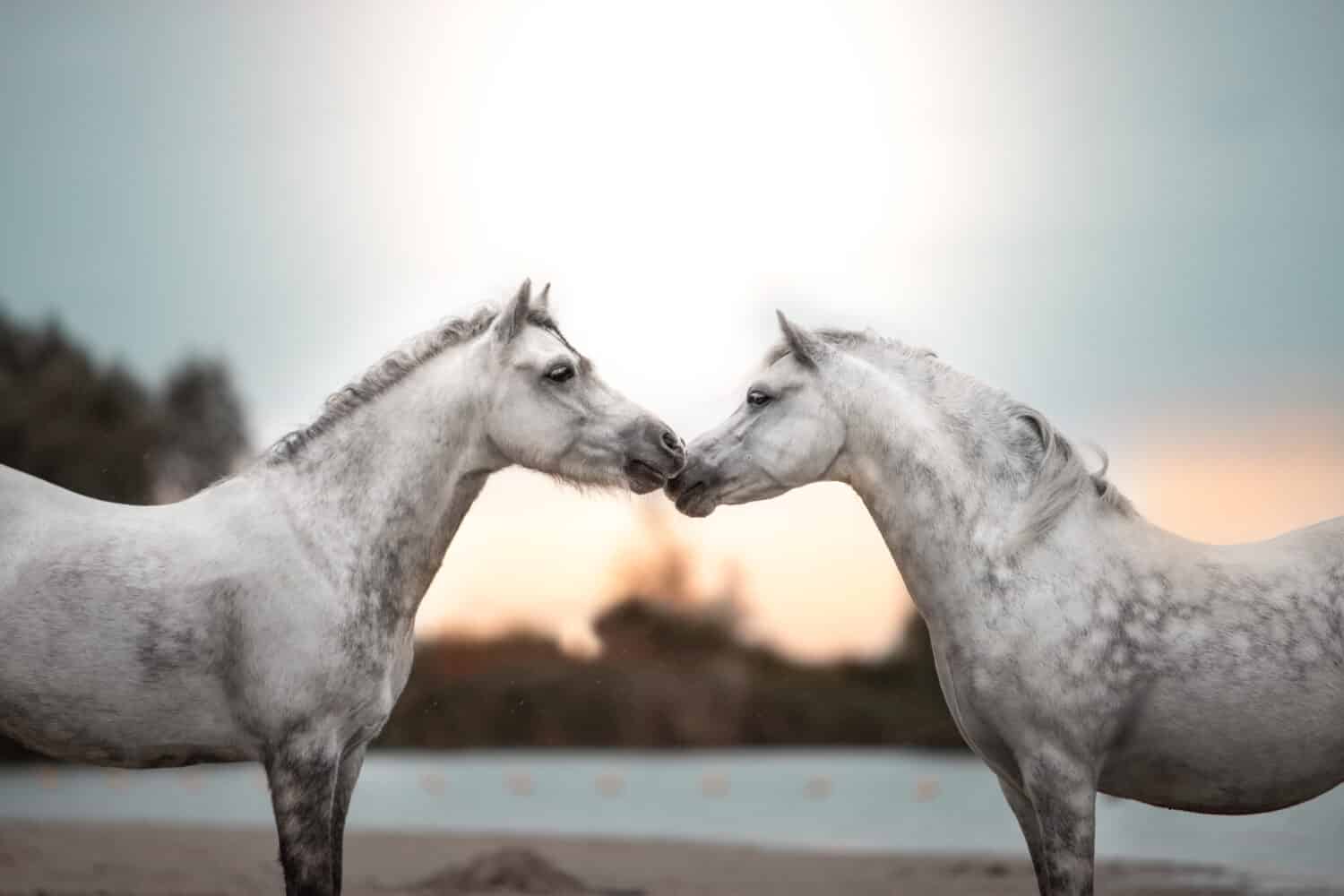
When a mare is in heat, her body gives singles through pheromones, hormones, and specific behavior.
©daliyah benhaim/Shutterstock.com
Natural and Artificial Fertilization
Fertilization, the union of sperm and egg, marks a significant milestone in the equine reproduction journey. This stage is a delicate dance of nature, leading to the creation of new life.
The Natural Process
In the natural process of a mare falling pregnant, the mare and stallion engage in a courtship. During the mare’s estrus, also known as the “heat” phase, her body signals readiness for mating. The stallion senses this through her pheromones and behavior, and he, too, undergoes behavioral changes, becoming more interested in the mare.
Once the mare and stallion partake in copulation, once complete, the stallion’s sperm then embark on a journey to find the mare’s egg, navigating through the mare’s cervix and into the uterus. If a mature egg is present, fertilization may occur in the oviduct, the tube connecting the ovary and the uterus.
Assisted Reproductive Technologies
In the artificial process of impregnating a horse, veterinarians may use assisted reproductive technologies (ART) to enhance the chances of successful fertilization. One common method is artificial insemination (AI), where the stallion’s sperm is collected, processed, and then deposited directly into the mare’s reproductive tract using specialized techniques and instruments.
Another ART technique is in vitro fertilization (IVF), in which mature oocytes are collected from the mare’s ovaries and then fertilized with sperm in a laboratory setting. Once the embryos are developed, they are transferred back into the mare’s uterus for gestation.
Veterinarians monitor the stage of fertilization in several ways. In the natural breeding process, they can observe the mating behavior of the mare and stallion to determine if copulation occurs during the mare’s estrus. They may also use transrectal ultrasound to monitor the mare’s reproductive tract for signs of successful ovulation and potential fertilization.
In artificial breeding methods, veterinarians closely monitor the timing of AI or IVF procedures, ensuring that they align with the mare’s reproductive cycle. Hormone assays and ultrasound examinations help determine the optimal time for insemination or embryo transfer.

The gestation period of horses ranges from 320 to 380 days.
©encierro/Shutterstock.com
Equine Embryonic Implantation
Following the fertilization stage in equine reproduction, there is early embryonic development. The embryo travels down the oviduct and reaches the mare’s uterus, where implantation takes place. During this early stage, the embryo undergoes a series of cell divisions, multiplying its cells to form a cluster known as a blastocyst. Approximately 7 to 9 days after fertilization, the embryo attaches and adheres to the uterine lining. This attachment, called implantation, allows the embryo to receive essential nutrients and establish a connection with the mare’s bloodstream.
Veterinarians carefully monitor the stage of implantation through various methods to ensure a healthy pregnancy. Transrectal ultrasound is a primary tool veterinarians use to visualize the uterus and observe the presence and location of the implanted embryo. This non-invasive technique allows veterinarians to confirm successful implantation and assess the overall health of the pregnancy.
In some cases, veterinarians may also use hormonal assays to measure specific hormones associated with pregnancy, such as progesterone. Progesterone levels play a crucial role in supporting the pregnancy and ensuring proper uterine conditions for the embryo’s successful implantation and growth.
Monitoring the stage of implantation is vital to detect any potential complications early on and take necessary measures to support the pregnancy. In some instances, veterinarians may administer hormone treatments to help maintain proper hormonal balance and support a healthy uterine environment.
While embryonic development is an awe-inspiring natural process, assisted reproductive technologies (ART) can also aid in monitoring and enhancing embryo growth. There are also techniques such as embryo flushing and transfer. This is where veterinarians collect the embryo from a genetically valuable mare and transferred it to a recipient mare, allowing veterinarians to optimize successful pregnancies for specific breeding intentions.
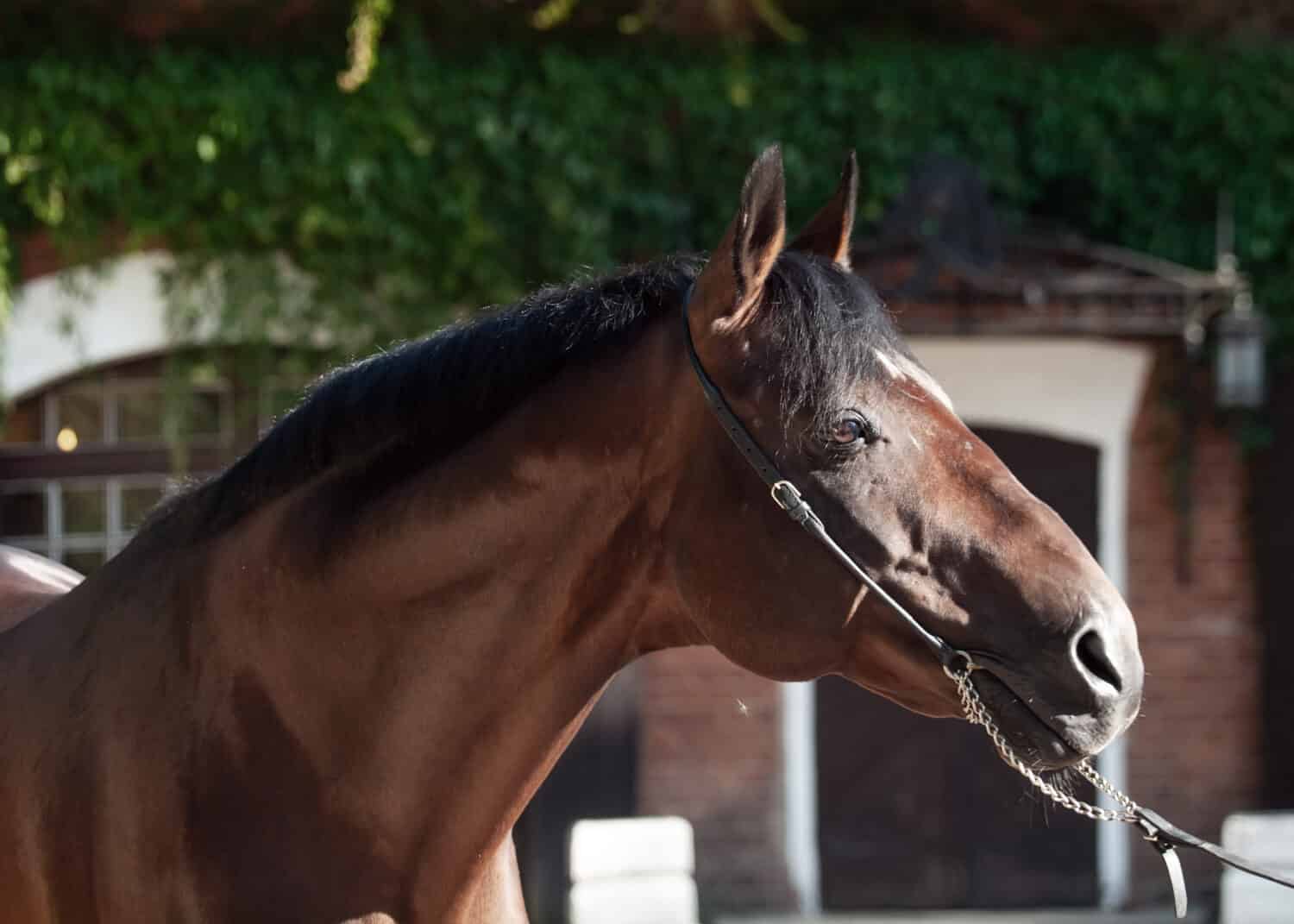
Due to the presence of hormones such as testosterone, stallions (intact male horses) may have thicker or more cresty necks. They also have a slightly more muscular physique, when compared to geldings (castrated male horses) or mares (female horses).
©anakondasp/Shutterstock.com
Equine Gestation and Fetal Development
Gestation is the period of pregnancy in horses during the equine reproduction process. It is a fascinating journey lasting on average approximately 340 days. However, it can vary from 320 to 380 days. During this period, the fertilized embryo evolves into a thriving fetus, undergoing various stages of growth and organ formation.
Veterinarians monitor gestation and fetal development through regular check-ups and diagnostic techniques. A widely used tool is transrectal ultrasound, which assesses the growth and well-being of the fetus. This non-invasive procedure allows veterinarians to visualize the developing fetus and measure its size. As well as evaluate the presence and function of essential organs.
Throughout gestation, veterinarians may conduct hormonal assays to measure hormone levels, such as progesterone, which play a pivotal role in supporting the pregnancy and maintaining a healthy uterine environment. Monitoring hormonal changes helps veterinarians detect any potential issues and allows for timely interventions if needed.
As the pregnancy progresses, veterinarians may perform additional ultrasound examinations to assess the positioning and presentation of the fetus in the uterus. This information is essential in predicting potential complications during labor and delivery.
During the final months of gestation, veterinarians continue to monitor the mare’s overall health and nutritional status. They ensure the mare receives the proper care and nourishment needed to adequately support herself and the growing fetus.
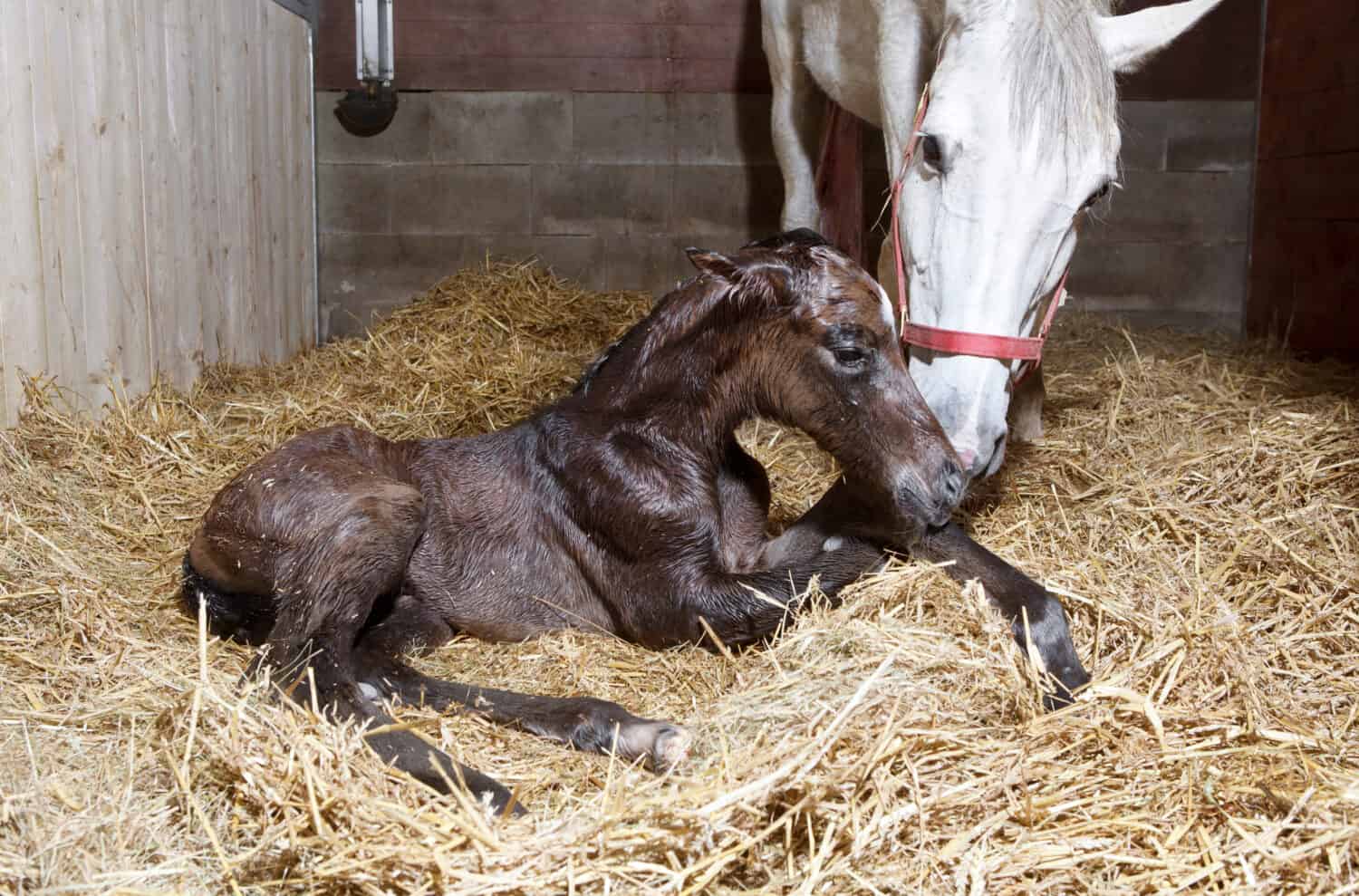
During the foaling process, mares typically deliver foals within 20-60 minutes of beginning labor.
©pfluegler-photo/Shutterstock.com
Birth aka Foaling
The stage of birth in horses, also known as foaling, marks the breathtaking conclusion of the equine reproduction process. Foaling typically occurs when the mare reaches full term, which is around 340 days of gestation on average.
Owners, breeders, and veterinarians closely monitor the stage of birth through observation. They may use modern technologies like foaling cameras to keep a watchful eye on the mare. Foaling cameras allow veterinarians and caretakers to remotely observe the mare’s behavior and readiness for foaling. This can help ensure they can be present for the birth and help with any complications that may arise.
During the actual foaling process, veterinarians may be present to assist if needed. While most mares can give birth without human intervention, some situations may require human intervention to ensure a safe delivery, such as when the foal is in an abnormal position or when other complications arise. The birthing process itself consists of three stages.
The First Stage of Birth
The first stage is the pre-foaling stage. It is characterized by behavioral changes in the mare, indicating that labor is imminent. The mare may become restless, paw the ground, shift her weight frequently and may appear anxious. The udder may also become engorged with milk, and the teats may start to wax, which is the appearance of a waxy substance on the tips of the teats. This stage can last anywhere from a few hours to a few days.
The Second Stage of Birth
The second stage consists of active labor. The mare experiences strong and rhythmic contractions as the foal moves into the birth canal. The amniotic sac surrounding the foal breaks, and the foal’s front feet and head emerge first. The foal’s nose should be facing the mare’s hind legs, which is the correct presentation for normal delivery. The mare may lie down and stand up repeatedly during this stage, and she may vocalize. The delivery of the foal usually takes about 20 to 30 minutes, but it can vary.
The Third Stage of Birth
The third and final stage takes place after the foal is born. The mare typically delivers the placenta within one to three hours. However, it can take up to eight to twelve hours without clinical signs of illness. The placenta is the organ that nourished and supported the foal during gestation. Veterinarians and caretakers monitor the mare to ensure the complete expulsion of the placenta and intervene if the placenta is retained. If a partially or fully retained placenta occurs, it can lead to life-threatening complications and infections. If needed, veterinarians will administer oxytocin, a hormone that helps stimulate uterine contractions and facilitate the expulsion of the placenta. Or they may manually remove the placenta.
Additionally, veterinarians examine the placenta after it is expelled to check for abnormalities or signs of infection. The placenta can provide valuable information about the health of the pregnancy. It can help veterinarians identify any potential issues that may have occurred during gestation.
After birth, the veterinarian’s role shifts to monitoring the health and well-being of both the mare and the newborn foal. The first few hours of the foal’s life are critical. A healthy foal can stand within one hour and begin nursing within two hours of being born. Urgent veterinary intervention is critical if they do not reach these two essential milestones, as newborn foals can decline quickly. Veterinarians may also perform a neonatal exam on the foal to assess its vital signs, reflexes, and overall health.
In the days and weeks following birth, veterinarians will continue to monitor the foal’s growth and development. They will also provide essential care and address any health concerns that may arise. They may administer vaccinations, check for congenital abnormalities, and ensure proper nutrition for the mare and foal.
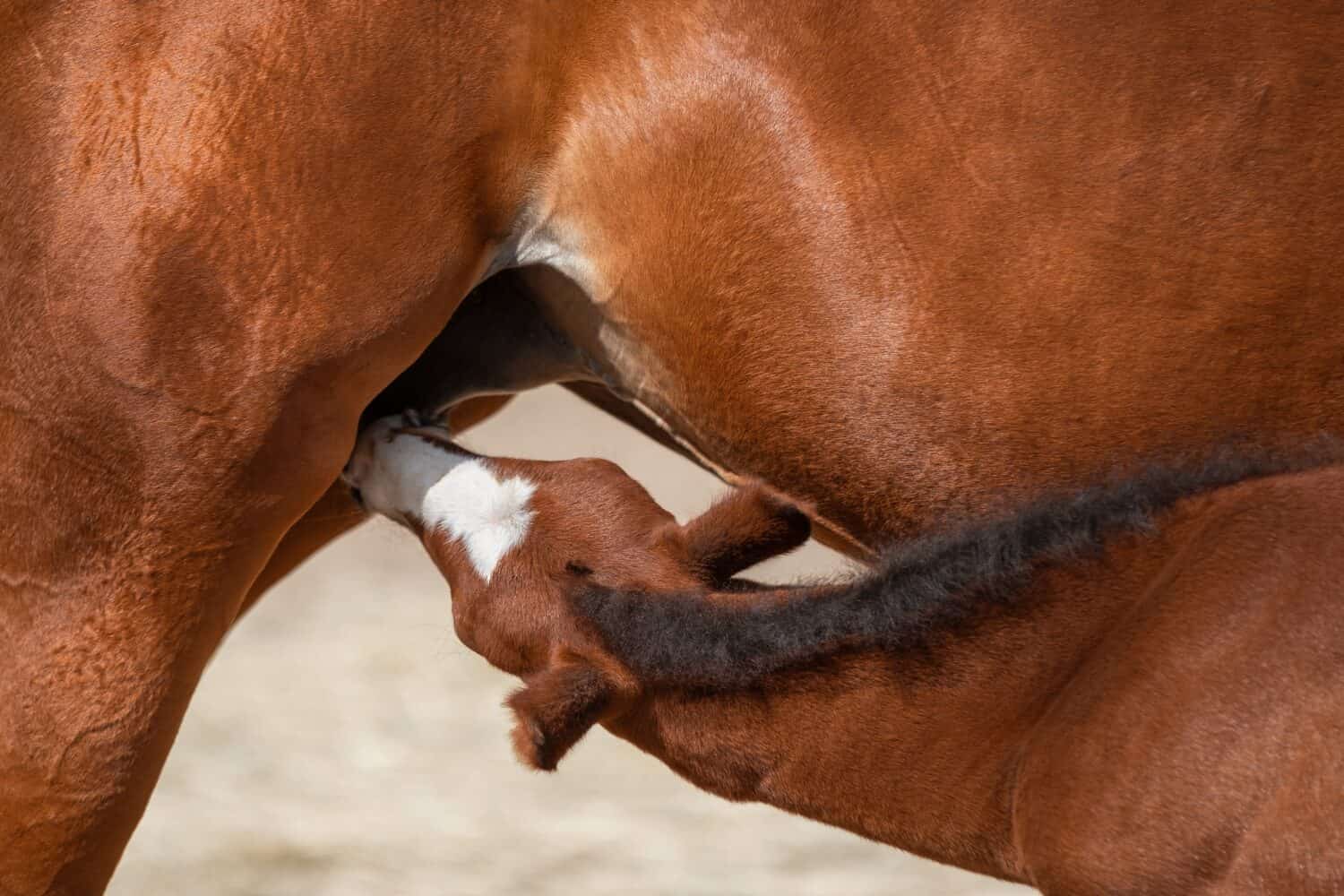
Healthy foals stand within the first hour of birth and begin nursing within the second hour.
©marinat197/Shutterstock.com
Conclusion
It’s important to note that the equine reproductive cycle can vary from one individual to another. Some mares may have irregularities in their cycles or experience difficulties in conception or during pregnancy. In such cases, working closely with a veterinarian or equine reproductive specialist is essential to address any issues. As well as optimize the chances of successful conception and healthy foaling. The American Association of Equine Practitioners is a great resource regarding equine reproduction.
Overall, equine reproduction is a captivating journey that encompasses various stages. Each stage is essential for the creation of new life. This includes from the mare’s estrous cycle, through fertilization, embryonic development, and gestation, to the moment of birth. Owners, breeders, veterinarians, and even reproductive specialists play a pivotal role in closely monitoring each stage. Often utilizing the use of advanced techniques or therapies. Whether through intentional breeding or not, their expertise ensures successful breeding, healthy pregnancies, and the well-being of both mares and foals.
Thank you for reading! Have some feedback for us? Contact the AZ Animals editorial team.





